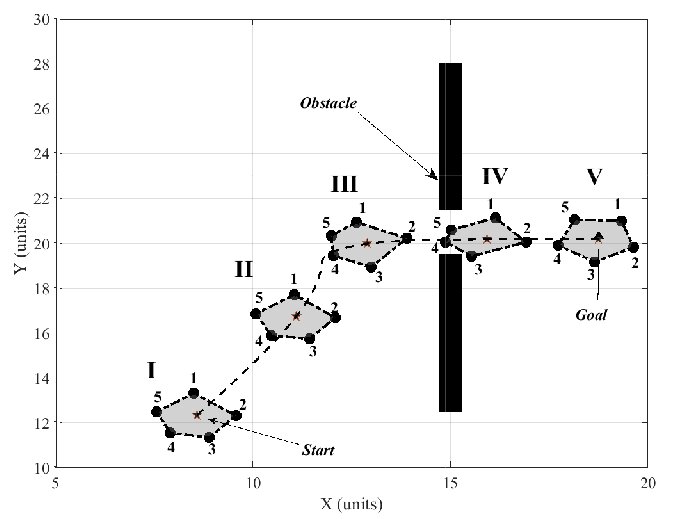Multi-robot systems have recently been used to tackle a variety of real-world problems, for instance, helping human users to monitor environments and access secluded locations. In order to navigate unknown and dynamic environments most efficiently, these robotic systems should be guided by path planners, which can identify collision-free trajectories for individual robots in a team.
Researchers at the Indian Institute of Technology Gandhinagar recently developed a new path planning approach for multi-robot systems. This technique, presented in a paper pre-published on arXiv, places a virtual agent at the center of a robot team formation, which ensures the organization and maintenance of the formation, allowing for formation flexibility to effectively navigate obstacle-ridden environments.
“Compared to a single robot, using multi-robot systems made of smaller dedicated robots working in collaboration could have several advantages,” Prof. Madhu Vadali, one of the researchers who carried out the study, told TechXplore. “For instance, these systems allow for better coverage, better performance, more flexibility, reliability and versatility. It is possible to swarm multiple robots operating in predefined formations to deal with complex tasks, and failure of one or more robots would not affect the task completion.”
Path planners are techniques that try to identify efficient and collision-free paths that robots should follow to travel from their initial location to a desired destination or to successfully complete their missions. Multi-robot path planners typically work by trying to ensure that robots navigate smoothly, while also maintaining a rigid formation.
In contrast with other path planning techniques proposed in the past, the approach developed by Prof. Vadali and his colleague Dr. Rohith G. allows for more flexible team formations. To achieve this, the approach utilizes a so-called artificial potential field (APF), a path planning algorithm that tries to identify minimum energy paths that allow individual robots in a team to reach a specific goal. To find these minimum energy paths, every robot replans its path according to the position of obstacles and other robots in its surroundings, to avoid collisions.
“In essence, our algorithm enables a formation of robots to squeeze through narrow gaps between obstacles,” Rohith said. “The uniqueness of this approach is that while a central planner plans a path at the center of the formation, individual robots within the formation ‘selfishly’ plan their deviations from this centrally planned path to avoid collisions.”
The algorithm developed by Madhu and Rohith essentially uses a ‘virtual agent’ located at the center of a robot formation to maintain the formation and organize all agents within it. The path of this virtual agent is planned centrally, while other robots in the formation are ‘forced’ to adapt to it and move along with it.
“This quasi-centralized approach, wherein individual robots selfishly deviate from a centrally planned path to navigate without any collisions, is similar to practices and strategies found in nature, where agents in a formation move in a centrally planned path, but each agent selfishly ensures that it does not collide with obstacles in its environment,” Madhu said.
Prof. Vadali and Dr. Rohith G. evaluated their algorithm by running a series of analyses and tests. Their results were highly promising, as their algorithm effectively allowed a pentagonal multi-robot formation to squeeze through a narrow passage without colliding with the walls delineating the passage.
In the future, the new path planning approach developed by the two researchers could have a variety of valuable applications. It could be particularly useful for applications that may benefit from flexible swarm formations, such as robot teams designed to transport or deliver objects, as well as multi-robot surveillance, crowd control, and security systems.
“So far, we focused on the theoretical aspects of the proposed flexible formation approach,” Madhu said. “We are now planning to implement the algorithm on a group of heterogeneous robots, to demonstrate its suitability for multiple practical applications. Furthermore, to make it much more applicable to real-life applications, such as autonomous vehicles, we wish to implement it in environments with moving obstacles.”
A flower pollination algorithm for efficient robot path planning
More information:
A quasi-centralized collision-free path planning approach for multi-robot systems. arXiv:2103.10316 [cs.RO]. arxiv.org/abs/2103.10316
2021 Science X Network
Citation:
A technique to plan paths for multiple robots in flexible formations (2021, April 20)
retrieved 20 April 2021
from https://techxplore.com/news/2021-04-technique-paths-multiple-robots-flexible.html
This document is subject to copyright. Apart from any fair dealing for the purpose of private study or research, no
part may be reproduced without the written permission. The content is provided for information purposes only.



